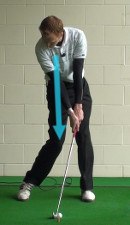
No golf tip has been repeated more often, with more unintended consequences, than “Keep your head down.”
The problem is, too many golfers take the phrase literally. They stiffen the neck, which tightens the shoulders, which restricts the swing, which causes all sorts of bad golf shots.
Even if the golfer remains tension-free, trying to keep the head still – e.g. your eye on the ball – prevents him from rotating the upper body into the follow-through.

As long as you understand the importance of watching the ball until the instant of impact, you're better off forgetting the “head-down” mantra entirely. Once the ball has been struck, the head should turn toward the target as the right shoulder turns underneath it. (For left-handers, it's the left shoulder.)
It may seem like anything that happens after contact is inconsequential – not true. Because the golf swing is a rapid motion, any post-contact movement begins before impact. If your head stays planted in position all the way to your finish, you will have inhibited the shoulders on the downswing, causing the arms to race ahead. The likely result is a loss of power and a pull or hook.
Allow your head to rise naturally with the motion of your shoulders on the follow-through. You'll hit longer, straighter shots.
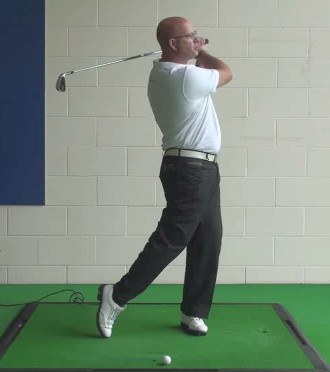
Why Your Follow Through Should Bring Your Head Up
If you have only heard one golf tip in your entire life, it was probably this one – 'keep your head down'. This is classic golf advice, and it is the first tip most people receive when they start in this game. And, of course, it is a solid piece of advice. You are going to have trouble hitting the ball cleanly if you can't see it, so you do need to keep your head down while the club whips through the hitting area. However, it is possible to take this tip too far, and many golfers do just that.
In this article, we are going to discuss why it is a good idea to allow your head to come up during the follow through. Notice that we are not talking about the downswing of the moment of impact, here. During those phases of the swing, you should have your head down, just as you have been instructed. However, once impact has been reached and the ball is on its way, it is perfectly acceptable – and recommended – to allow your head to come up along with the rest of your body. Doing so will result in an organized, balanced finish that repeats swing after swing.
Learning to allow your head to come up in the follow through might not seem like a big deal at first. After all, the ball is already gone, so how much effect could this tip have? Quite a significant effect, as it turns out. When you correct a mistake you may have been making in the follow through, you will actually improve everything that comes before it as well. The follow through is a like a road map to the rest of your swing – it will tell an important story about your technique. Get the finish right and everything that came before is likely to be in good shape.
Of course, you won't be surprised to learn that this point is not the only key to focus on in your swing. If you simply learn how to let your head come up in the follow through, without paying attention to any other keys, you probably aren't going to reach your goals. Work on this important point, but work on other points as well to make sure your swing as a whole is moving in the right direction.
All of the content below has been written from the perspective of a right-handed golfer. If you happen to play left-handed, please take a moment to reverse the directions as necessary.

Set Yourself Free
The biggest problem with keeping your head down too long in the golf is that it can restrict your freedom of movement. Your head should be down through impact because you need to keep your body stable in order to make a clean strike. However, if you were to keep your head in that same position as you move into the follow through, you wouldn't be able to rotate at full speed. You would need to slow things down in order to stop sooner, as you can't get to full finish position without bringing your head up. In the end, you would be making a weak swing which lacks the potential to hit the ball any significant distance.
You want to feel free to swing through the ball aggressively. Golf is not all about distance, but you do need to be able to at least generate moderate speed in order to move the ball toward the target. The rotational forces you are going to use in the downswing are powerful, and you won't be able to combine those with a stubborn head position. If you try to keep your head down, something is going to have to give. Either you will hurt yourself by trying to swing through and keep your head down, or you will fail to swing up to your full potential.
Telling yourself that it is okay to let your head come up in the follow through is a big step toward a freer, more powerful swing. No longer will you feel forced to fight back against the power of your body rotation on the way down. You will know that you don't have to hold your head steady through the strike and into the follow through – as long as you keep your head down through impact, you can let yourself finish the move naturally from that point. This is how the best golfers in the world play the game, and you should be following their lead.
We mentioned above that trying to keep your head down could lead to injury, but we need to revisit that point because it is important. While golf does not have a reputation as a particularly demanding game from a physical standpoint, it can wear on you as the years go by. Specifically, back problems are common among golfers, as the twisting motion required to play this game can be tough on the back.
With that in mind, you don't want to do anything that will make this game harder on your body than it needs to be. Keeping your head down after impact has occurred in an unnatural motion which will potentially lead to injury. There is simply no need to put yourself in that type of situation. Let your head come on up along with the rest of your body as you swing through, and you should take plenty of stress away from your back and neck. Does this mean you won't get hurt while playing golf? No, of course not – but it is a step in the right direction.
Freedom is a great thing in golf. You should feel free to make a powerful swing without holding anything back, and you should feel free to make your best swings on the course. Trying to restrict yourself in some way is only going to lead to negative results. Now that you know it is okay to let your head come up when you move into the follow through, you can take your newfound freedom and apply it to every club in your bag. As you start to feel the freedom that comes with bringing your head up in the follow through, you should quickly notice an improvement in your level of play.
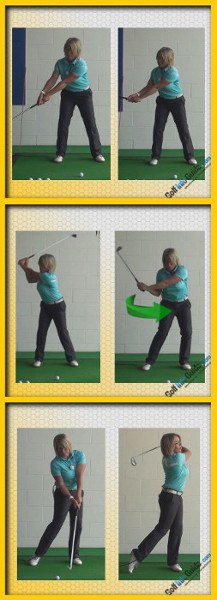
Executing This Move
In many ways, you don't really have to think about this move. It is natural to let your head come up in the follow through, so all you have to do is not stop that from taking place. As long as you aren't actively preventing your head from moving up along with the rest of your body on the way through, you should be in good shape.
With that said, there are some keys you can use to make sure you are using your head correctly during the swing. As you practice your technique on the driving range, keep these tips in mind.
- Watch a very specific spot. This is one of the best ways you can both keep your head down and also let it come up when the time is right. At address, pick out a very specific spot on the golf ball to watch as your swing develops. By 'very specific', we don't mean just watching the top of the ball, or even the back of the ball. You can do better than that. To focus your eyes as tightly as possible, use one of the markings on the ball, or draw your own unique marking before you start playing. The number that comes printed on your ball is a good place to start. If you focus your eyes on that marking and then start your swing, it should be easy to keep your head and eyes still while hitting the shot. Once the ball is gone, the marking will be gone as well, and you will be free to let your head come up into the finish.
- Chase the ball. The swing is not over when the ball is struck. This is a common misunderstanding which gets in the way of many amateur golfers – countless players feel like their job is done as soon as the ball leaves the club face. Instead of giving up on your swing at that moment in time, you should feel like you are chasing the ball down the line and toward the target. As the ball leaves, your right hand should be extending the club toward the target, and your head should be moving up and slightly to the left as well. The movement of your head should not be forced, but rather it should be a comfortable reaction to the momentum of your swing.
- Finish in an upright position. As you are making your swing, you can already be thinking about the finish position. This is actually a great way to focus your mind on a goal which you can control – think about where you want your body to finish, and then make it happen. Rather than thinking only about where the ball is going to go, you will have more direct control over this outcome. Strive to put your body in an upright position at the end of the swing, with your spine in perfect alignment from top to bottom. If you can make that happen, there is a good chance your head will have behaved properly.
- Let in happen. In this end, bringing your head up in the follow through is something that should happen naturally, as long as you don't stand in the way. Many golfers, thinking that they need to keep their head down for as long as possible, prevent their head from coming up. That is a mistake, and a potentially serious one. While the golf swing doesn't end until you have arrived at a balanced finish position, you are done worrying about your head position the moment the ball leaves the club face.
Your swing will feel far more comfortable, and natural, when you let your head come up in the follow through. There is a big difference between letting your head come up in the follow through and lifting it up early. Feel the club rip through the ball, continue turning toward the target, and let your head come along for the ride. When done properly, you will instantly feel a sense of comfort and confidence in your swing.
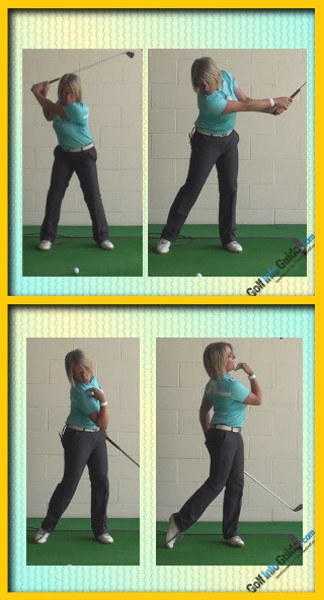
Strike a Pose
When you see pictures of professional golfers, you might notice that those pictures tend to be taken at the same point time after time – they are usually captured when the player is posing in his or her finish position, watching the ball sail toward the target. This is a great time for photographers to do their work, as every player holds this position while watching the ball fly. The golfer usually looks focused and determined, and they hold still for at least a few seconds.
While there might not be anyone taking your picture when you hit a shot, you should still think about striking a pose in your finish position. The ability to hold your finish says a lot about the swing which has led up to that finish. If you are able to stand still in the finish, with your head up, long enough to see the ball sail through the air and come back to the ground, you can be sure that most of the pieces of your swing are in the right place.
So what does a perfect finish position look like? Do your best to check off the points listed below.
- Weight balanced on your left side. When we say that you should be 'balanced' at the finish of your swing, that does not mean that you should have your weight evenly distributed between your right and left sides. Rather, most of your weight should be on your left foot, but you should be controlled and you should be able to hold that position for as long as needed. Your right heel should be up off the ground, with the sole of your right shoe facing away from the target. This is the classic golf finish position, and it has served players well for generations.
- Standing straight up and down. We mentioned this point briefly earlier. Your spine should be in alignment from top to bottom, and your head should be in a vertical position as well. It is okay to be slightly off of these guidelines, but you shouldn't be way off track. If you find that you're dramatically leaning in one direction or another, work on arriving at a better finish position in order to balance yourself out successfully. One helpful trick is to practice posing in a balanced finish position in front of a mirror, without actually making a swing. This will let you see exactly where your body should be at the end of the swing, and you will be able to feel that position as a result. Then, when hitting balls on the range or on the course, you can remember what that feels like and do your best to replicate it.
- Chest to the target. One of the biggest mistakes seen in the amateur golf swing is failing to move all the way through the ball and into the finish aggressively. Sometimes, this is the result of trying to keep the head down too long. In other cases, it is simply a result of not rotating the chest properly through the ball and beyond. Make it a goal to finish your swing with your chest facing the target that you had selected for the shot. If you can make this type of turn, your swing will become more powerful and your play should become more consistent as well.
For the average golfer, working on a proper finish position is a to-do item that comes in pretty low on their priority list. That is a shame, however, as finishing in the right position will help your play tremendously. You will be able to strike the ball with far more authority when you turn through your shots and wind up in a balanced finish position. Spend some upcoming practice time working on this part of your technique and it is nearly certain that you will make progress in short order.
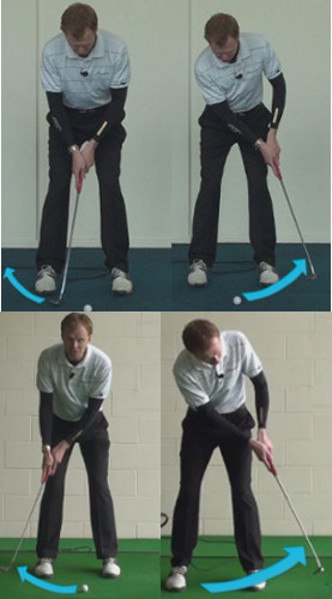
A Different Short Game Story
We have spent this article talking about how you can – and should – allow your head to come up in the follow through. It needs to be stated, however, that this advice only applies to the full swing. When you venture closer to the green and wind up in the territory of the short game, the story changes. Here, you are going to keep your head down all the way through the shot, even after the ball is gone.
You can keep your head down so long in the short game because you don't have to worry about the momentum of your swing carrying you into a full finish. The swings you make in the short game are small, and they lack speed. When putting, for example, the putter is usually moving rather slow through the ball, and there is no powerful body rotation to carry you up into a full finish. The story is the same when chipping. You will only be swinging the club a short distance back and through, so you don't need to allow your head to come up in the follow through. Just keep your head down, hold your eyes steady, and trust that the ball is on its way to the target.
It is important to keep your head down well beyond impact in the short game because the temptation to look up early is strong when you are so close to the hole. Many putts have been ruined by premature head movement – a mistake which is even made by experienced golfers. If you are thinking about letting your head come up in the follow through, you will be more likely to let it come up before impact has occurred. When you make that mistake, your shot will usually be sent off line, and you may get the speed wrong as well.
Since there is no need to let your head come up, it is better to just keep it in place. Again here, it is a good idea to watch a specific spot on the golf ball as you make your swing. When the ball is gone, keep your eyes down on the spot that the ball has vacated. It is recommended to keep your head down for at least a couple seconds before looking up to see how you've done. On short putts, you can just listen for the ball to drop in the cup, without looking up to watch it roll at all.
The only exceptions to this rule about keeping your head down in the short game are bunker shots and flop shots. If you are hitting an explosion shot from the sand, you will be making a big swing – and therefore, you will want to let your head come up as you follow through. The same can be said for a full flop shot from near the side of the green. Anytime you are making an aggressive, powerful swing, you want to allow your head to come up as you swing through. Otherwise, keep it down and keep your body as steady as possible.
Allowing your head to come up as you follow through is an easy decision. This move should make the game easier on your body, it should help you maximize your power through the hitting area, and it should lead to better balance from start to finish. During your next practice session, think about how your head is behaving after impact, and make sure you are letting it move freely into the finish. With this part of the swing addressed, you will be a step closer to reaching your goals on the course. Good luck!






